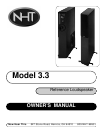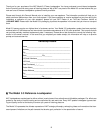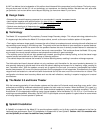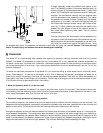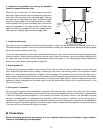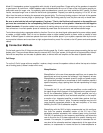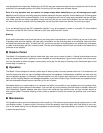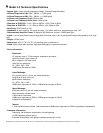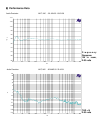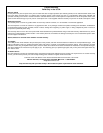
over-emphasize low frequencies. Additionally, the SA-3's low-pass crossover allows the user to adjust the rolloff of low fre-
quencies to the subwoofer sections for further fine-tuning of the low bass and mid-bass regions.
Note: It is very important that you remove the jumper straps when biamplifying or you will damage your ampli-
fiers! Connect the top pair of binding posts with speaker cable from the main amplifier, and the bottom pair of binding posts
with speaker cable from the second amplifier. If you are biamplifying with two full range stereo amplifiers that are not iden-
tical, make sure that one has an adjustable volume control so that you can match levels between the two. Both amplifiers
will need to be wired in parallel from the preamplifier, so that they both receive an identical line-level input signal.
If you are biamplifying with the SA-3 subwoofer amplifier, it may be connected in series or in parallel. For more detailed
information, consult the SA-3 Owner's Manual or your local authorized NHT retailer.
Biwiring
Some audio enthusiasts have found that biwiring can bring about improvements in sound. Biwiring is the use of two pairs
of speaker cable and one amplifier, with each pair connected to one set of binding posts on the amplifier (some two-chan-
nel amplifiers provide two sets). To biwire the 2.9's, connect the top pair of binding posts to the amplifier with one speak-
er cable, and the bottom pair with a second cable. The two sets of speaker cable are both connected to the same pair of
terminals on the amplifier.
!!
Break-In Period
The Model 3.3 loudspeakers will perform better after they have had a chance to break in. Several factors determine how
long this process takes and it depends on such variables as room temperature, type of music played, and volume level.
You may be aware of subtle changes in sound quality during the first few days of listening as the mechanical parts of the
drivers begin to loosen up.
!!
Operation
The Model 3.3 was designed to handle a wide range of listening levels, but every speaker has limits. It is important to use
common sense and listen for signs of possible distress from the speakers. Underpowered amplifiers are most often the
cause of speaker damage. For example, a 60-watt amplifier runs out of power when called upon to produce more than 60
watts, and the resulting distortion can damage the speaker. If you tend to listen at high volume levels, more powerful ampli-
fiers are preferable because they are less likely to run out of power.
Noticeable distortion or harsh breakup is an indication that either your amplifier or your speakers are running beyond their
capacity, and the volume should be decreased. If you can feel any heat emanating from the woofer or tweeter, reduce the
level immediately. Speaker damage most often occurs from sustained high volume levels, not from transient sounds or
brief musical peaks. Excessive boosting of bass, treble or equalizer controls can worsen the problem, and is not recom-
mended.
!!
Maintenance
Your speakers require minimal maintenance under normal use. The cabinet may be cleaned using a damp cloth or a mild,
non-abrasive cleaner. To clean the grille, first remove it from the speaker, then brush lightly with a soft brush or use a vac-
uum on its lowest setting. Do not expose the speakers to direct sunlight, high temperatures, or moisture. Do not attempt
to clean the actual drivers.



